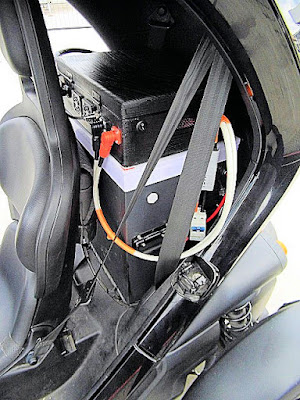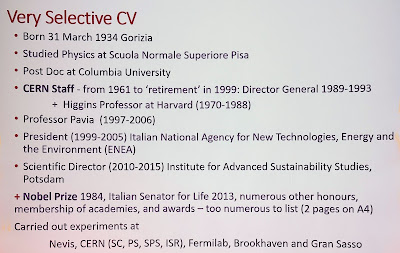On March 31, Carlo Rubbia, Noble Price winner and former CERN director
general, celebrated his 90th birthday. On this occasion, CERN organized a
scientific symposium on October 18, which Red Baron, only 14 months younger than
Carlo, attended.
On that day, I took the southbound ICE 271* at 8:05
from Freiburg to Zürich, changed trains at Basel, and arrived in Geneva at
11:47.
*Intercity-ExpressSome recollections of my encounters with Carlo flooded back during
this train journey.
Professor Rubbia was my director general (DG)
from 1989 to 1993, but I met him first in the late 1960s when he was already an
ambitious physicist. At that time, CERN's high-energy workhorse was the 26 GeV
Proton Synchrotron (PS), which spit its secondary particle beams into the East
experimental hall.
Carlo had an experiment in that hall and insisted
on having access to an area around his beamline. However, measurements of my
radiation protection section showed that radiation levels were too high to allow
access.
In those times, the radiation protection rules at CERN were
as follows:
My section reported to the divisional radiation
protection officer (RSO of the PS Division). The PS-RSO, Jack F., was a former
British colonial officer with a stiff lip. His yellow fingers stuck out because
he was a heavy smoker of unfiltered Navy Cut cigarettes. As a youngster at CERN,
I liked and even admired Jack, for he spoke perfect Queen's English. We met over
a cup of coffee several times during the week to discuss the radiation situation
around the PS accelerator.
Suddenly, we three stood in the East Hall
on top of concrete shielding blocs: Carlo requesting access to his beamline, the
PS-RSO Jack F. denying and, in his perfect English, arguing with Carlo, and me,
the physicist who had delivered the measured dose levels. They exchanged strong
arguments, but Carlo accepted my interjections because I was a physicist.
Eventually,
the two men agreed on a compromise I could accept as the radiation protection
guardian. But the whole affair left a bitter aftertaste.
The second
time I ran into Carlo was in a hallway in the spring of 1989. He stampeded out
of his office and caught me, "Look what Fleischman and Pons do in the States,
and we all are sleeping here," waving the paper of
Martin Fleischmann
and
Stanley Pons
in his hands titled "
Electrochemically Induced Nuclear Fusion of Deuterium."
In the following days, I provided him and other teams at CERN
with neutron detectors so that my RP-Group could hardly fulfill its radiation
protection tasks. And, yes, even Cold Fusion, if it works, will produce radiation!
To make the fusion story short, eventually, a CERN spokesman said
that "essentially all" attempts in Western Europe to reproduce Fleischmann's
and Pons's results had failed. This means that Cold Fusion did not, and I add
that it will not work. Red Baron blogged
on cold fusion in 2011.
My third encounter with Carlo was an indirect telephone
contact in the early spring of 1990. I was on my way to
a scientific meeting on radiation dosimetry at Gaussig
near Dresden and had, exceptionally, taken my car. While on my way and
following Germany's reunification, I wanted to see as much as possible of the
now accessible parts of my home country that are regarded as Germany's
heartland.
I was just climbing the Kyffhäuser monument when my
mobile telephone rang. The DG's secretary called, "He wants to see you in his
office at 2 o'clock."
I answered that I couldn't make it because I
was traveling in Germany, but the DG could always contact my deputy at CERN.
On my return, the latter told me he had discussed the query with the DG on the
phone. Apparently, he had answered to Carlo's satisfaction so I could finish
my travel to Gaussig without further disturbance.
My last physical
encounter with Carlo was during a presentation* I gave to the CERN Directorate
on the existence of radioactive waste at our premises. CERN's host countries,
France and Switzerland, requested a report on the quantity concerned.
*My first PowerPoint presentationWhen high-energy particles hit matter, radioactivity is created
by spallation of nuclei and neutron interactions. However, unlike radioactive
waste produced by nuclear fission in power reactors, radioactivity from
accelerator operation has low specific activity and a short half-life.
Nevertheless, the specific and total radioactivity in tons of
steel, aluminum, copper, and concrete kept on the CERN premises and waiting to
be disposed of is too high to be released into the environment simply.
The
discharge of CERN's low-level radioactive waste into the national depositories
of France and Switzerland is costly, and the Directorate must decide how to
spend the money.
Back to my trip.
I took the
streetcar to CERN and wanted to book into the CERN hostel, but my room was not
ready. So, at around 1 pm, I left my luggage in a locker and went to the
Main Building.
The auditorium was prepared but still empty. I chose my seat in the middle of
row four to have a clear view of the projection screen during the lectures,
taking photos for this blog.
I left my coat on the seat and went to
the cafeteria to get something to bite on. When I returned half an hour later,
the lecture hall was already well-filled. Surprisingly, I noticed they had
reserved a seat for Carlo in row three just before me.
I took my
seat and suddenly found myself surrounded by Italians. I have always admired and
still admire not only Italian culture and cuisine but also Italian physicists,
who at CERN had the most brilliant ideas following the footsteps of Galileo
Galilei's heritage. However, when it came to the realization, they needed the
help of
i tedeschi e i britannici.
Suddenly, the people in the row in front of me stood up. Carlo arrived and did
lots of handshaking with his compatriots on his way to his seat, but he didn't
catch my eye.

|
|
Carlo had headphones on, and I wore my hearing aid.
|
I could barely see CERN's present Italian DG,
Fabiola Gianotti. As chairwoman, she welcomed the participants of the symposium in English
and opened the session.
Sir Christopher Llewellyn Smith, CERN's DG from 1994 to 1998, started the
series of lectures.
Carlo greets his successor as CERN's DG by raising his hand.
Chris showed one very selective
curriculum vitae of Carlo.
He and Carlo first met in October 1982 as founding members of the SPSC*.
Chris recollects,
"I was immediately impressed by the enormous breadth of his knowledge of
physics, detectors, and accelerators, his quickness - he grasped points
before anyone else - and his originality and deployment of English."
*Super Proton Synchrotron Committee
In early 1977, Carlo Rubbia wrote a report on the feasibility of
proton-antiproton (p-pbar) collisions in the SPS and, on March 1, invited
30 physicists at CERN and in its Member States to a study week to discuss
a possible detector.
Opposition to the project came from a number of people who argued that at
a time of economic stringency, CERN should not do something which would
otherwise be done by Fermilab (USA) and others ...
(John) Adams
countered this by pointing out that in the SPS machine, not only were the
magnets more reliable, but the greatly superior vacuum would give a beam
lifetime of 18 hours, compared to 150 seconds at Fermilab.
On June 8, 1978, CERN's Executive Board officially decided to
proceed with the p-pbar project and UA1 (Carlo's experiment)
At 5 am on July 10. 1981, collisions were observed in UA1.
Meanwhile, on July 1. 1983, the HEPAP* pushed for a 40 TeV
Superconducting Super Collider (SSC) in the US to "regain US
leadership."
*High Energy Physics Advisory Panel in the US.
CERN countered with the LHC, which has only 14 TeV but a higher
luminosity, i.e., the number of possible collisions.
This
luminosity/energy trade-off had to be understood, but it was questioned
whether a luminosity of 1033 cm2 s-1
could be used.
At the BNL* 1983 Summer School, Carlo said of a luminosity as
high as 1033, "It is a matter of learning how to handle it."
*Brookhaven National Laboratory on Long Island, NY.
Today, the LHC's luminosity is up to 2 x 1034 cm2
s-1 and is expected to increase to 5 - 7.5 x 1035
cm2 s-1 in the future.
After Carlo
became DG on January 1, 1989, he stressed that compared to the SSC
- the higher luminosity would largely compensate for the lower
energy
- LHC would also offer heavy ion collisions at unprecedented
energy and ep collisions (the intention then being to leave LEP in
place).
In 1974, the situation in physics was summarized as scenario zero: there
is nothing more than the particles we now have in our models, which we
call the Standard Model.

|
|
Gerard's Standard Model
|
What was needed most urgently was a direct observation of the W±
and Z0
vector particles.
Some theorists warned that the predicted particles would be too
heavy to ever be observed, but Carlo emphasized, "Theorists should not
worry. If these particles exist, we experimentalists will find them."
In 1982 and 1983. these particles were observed in p-pbar collision at
CERN.
Gerard added,
"I wish theoreticians could say, 'Experimentalists should not worry;
we'll make a theory that explains what you are finding.'"
But here we are not very successful.
Astronomy
- Red Baron would say Astrophysics -
is doing better.
Before the p-pbar collider became a reality, groundbreaking R&D work had
to be done.
Lyn Evans, former LHC project leader, centered his talk around the stochastic
cooling of proton and antiproton beams. This "cooling" will narrow the
transverse momentum distribution within a bunch of charged particles by
detecting fluctuations in the momentum and applying a correction.

Here is a photo of the ICE* installation, the Initial Cooling Experiment at
CERN.
* Another and different ICE
Beam cooling allows particle densities to be achieved sufficient to observe a
high rate of proton-antiproton collisions. And cooling worked!
It follows a sequence of slides illustrating the discovery of the
intermediate vector bosons.
The W bosons are named after the weak force.
The Z boson is named after its electrical neutrality (zero
charge).


|
Note the handwritten measurement protocol.
|

|
|
Carlo at the overhead projector
|
On January 20, 1983, Carlo announced the discovery of the W-Boson to the CERN
community. The Main Auditorium was packed, and Red Baron was present.

|
|
Carlo's finger on the overhead foil points to the theoretically
predicted value of the W-Boson.
|
Carlo said, "That is to be compared with the Weinberg Salam prediction, which is 82.1
± 2.4 GeV/c2, including all the higher corrections … So we
would like to quote this number (mW = 81 ± 5 GeV/c2)
to be compared with that number (mW = 82.1 ± 2.4
GeV/c2), which, by the way, is not so bad." Carlo followed his announcement with a relieved chuckle.
Given the many other awards Carlo has received during his academic life,
the INFN Medal seems like a trifle.
He looked at me and countered, "I was responsible for radiation protection." He was so right. At CERN, the DG is responsible for everything that happens in
the Organization. So, I hastily added, "I was head of the radiation
protection group." He briefly smiled at me and then turned to a more
familiar face speaking Italian.
I have not forgotten Carlo's ideas on an energy amplifier and
superconducting power lines. These topics were discussed at the symposium,
but a presentation here would overload the blog. I will perhaps report on
this later. Here is a short foretaste of the
Rubbiatron
presented in a blog in 2011.
*























































